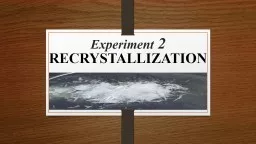

Solid organic compounds when isolated from organic reactions are usually impure they are usually contaminated with small amounts of other compounds that are produced along with the desired compound The purification of impure crystalline compounds is usually done by recrystallization from a suita ID: 913950
Download Presentation The PPT/PDF document "Experiment 2 RECRYSTALLIZATION" is the property of its rightful owner. Permission is granted to download and print the materials on this web site for personal, non-commercial use only, and to display it on your personal computer provided you do not modify the materials and that you retain all copyright notices contained in the materials. By downloading content from our website, you accept the terms of this agreement.
Slide1
Experiment 2
RECRYSTALLIZATION
Slide2Solid organic compounds when isolated from organic reactions are usually impure; they are usually contaminated with small amounts of other compounds that are produced along with the desired compound. The purification of impure crystalline compounds is usually done by recrystallization from a suitable solvent or a mixture of solvents.
Liquids are customarily purified by distillation , while solids are purified by recrystallization (sometimes called simply crystallization). Insoluble impurities and colored impurities can be removed from hot solvent through the us of activated carbon and filtration .
Slide3Choosing a solvent for recrystallization: The proper choice of a solvent is an important part of the art of crystallization. The ideal solvent should:
Be chemically inert toward the solute.
Dissolve the solute readily at its boiling point but sparingly at low temperatures (0 – 25
0
C).
Dissolve impurities either very easily or not at all.
Be highly volatile so that it can readily be evaporated from the crystals.
Not be flammable, of low cost, and of low toxicity.
Slide4Practically, to choose a good solvent take about (0.1 gm) of the compound to be purified (a pure sample) and try to dissolve it in (1 ml) of the solvent;1-
if it dissolves in the cold solvent, the solvent will not be good for recrystallization2- if it dissolves in the solvent with heating, the solvent will be good for recrystallization
3-
if it does not dissolve in the solvent even with heating, the solvent will not be good for recrystallization.
Solvents extensively used for recrystallization include water, ethanol, chloroform, ether, acetone, and benzene.
Slide5Decolorizing charcoal: Frequently, samples to be purified may contain soluble colored impurities that may cause the solution and the crystals to be colored when they should be colorless; they dissolve in the boiling solvent and are adsorbed on the crystals produced upon cooling.
These impurities can be removed by treating the colored sample with decolorizing (activated) charcoal that is composed of fine carbon particles with a large active surface on which the colored impurities will be adsorbed.
Slide6Charcoal is added to the hot solution before boiling and the solution is kept hot at or near the boiling point for about 3-5 minutes with shaking to wet the charcoal. The solution is then filtered through a fluted filter paper. No more charcoal than actually needed should be used because any excess amount will cause the desired compound to be adsorbed on the charcoal.
Charcoal is not added at the boiling point of the solvent because its particles function as thousands of boiling chips causing the solution to boil over and foam.
Slide7Recrystallization using mixed solvents: This is applied when your compound is readily soluble in a solvent at room temperature, and at the same time is not soluble in another solvent. The two solvents must be completely miscible with each other such as alcohol and water, ether and pentane, and glacial acetic acid and water. So the compound is dissolved in the solvent that it is soluble in, charcoal is used if required, and the solution is filtered to get rid of the insoluble impurities. Then the over solvent (in which the compound is insoluble) is added to the filtrate gradually until turbidity appears. The mixture is then left aside to facilitate crystallization.
Slide8Notes:
1- If crystallization does not take place scratch the sides or the bottom of the container below the surface of the solution with in glass rod, add a small crystal of the pure compound, or evaporate some of solvent to induce the crystallization process.
2- The funnel, filter paper, and the container of the solution should be kept hot through out the filtration process to prevent the deposition of the crystals on the filter paper or on the neck of funnel. Therefore, it is recommended to wash the filter paper after completing the filtration process with a small amount of the hot solvent.
3- Use a minimum volume of the solvent to prevent the loss of the compound because large volumes of the solvent will keep most of the compound dissolved in it.
Slide9